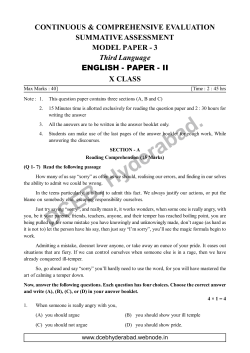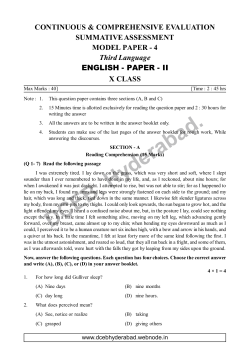
General Science - Paper - II (Set
MODEL PAPER - 3 1 PRE-FINAL - FEBRUARY - 2015 Model Paper - 3 GENERAL SCIENCE - PAPER - II (BIOLOGICAL SCIENCE) X CLASS Max Marks : 40] [Time : 2 : 45 hrs General Instructions : 1. Answer all the questions in separate answer sheet only. 2. This question paper comprises four sections, I, II, III and IV. There is internal choice in Section - I only. 3. All questions are compulsory. 4. In the time duration of 2 : 45 Hrs, 15 Min. of time is to read and understand question paper. b a r e d y H SECTION - I Instructions : . d a (4 × 4 = 16 M) (i) There is internal choice in section - I (ii) Each question carries 4 marks , B E C D (iii) Answer each question in 8 - 10 sentences each. 1. Explain the structure of chloroplast with a neatly labelled sketch ? OR Write a short note on pyramid of number for any two food chain ? What can we conclude from this pyramid of numbers ? 2. Write differences between - (Along with examples) (i) Autotrophic nutrition – Heterotrophic Nutrition (ii) Mastication – Rumination OR Give reasons for : (i) Why do we need hormones ? (ii) Urine is slightly thicker in summer than in winter ? (iii) If glucose level falls in blood we feel hungry. (iv) What leads to variations. 3. (a) Oxygen is produced during photosynthesis in the presence of light for conducting this experiment what apparatus you think you need. (b) Why do you place the apparatus in the sum for 2 – 3 hours ? www.dcebhyderabad.webnode.in GENERAL SCIENCE - PAPER - II 2 (c) What did you deserve after you kept the apparatus in sunlight. (d) Which has do you think was evolved during the experiment ? How do you confirm it ? OR Prove the presence of starch in green leaves. What experiment do you conduct ? What are the steps involved in this experiment ? 4. Name of the Phylum Organism Excretory System Annelids – Nephridia Protozoa – Simple diffusion from the body surface into the surrounding water Mollusca – Meta nephridia Reptiles, Birds and Mammals – Kidneys Echinodermata – Water Vascular System Porifera, Coelenterates – Water bathes almost all their cells Arthropoda – Green glands, Malpighian tubules – Flame cells Platyhelminthes and Nematoda b a r e d y H . d a (a) According to the order of phyla's list out the excretory systems. (h) What is the excretory system in unicellular organisms ? (c) Name the phyla which has malpighian tulriles. (d) In which phyla water bathes almost all their cells. , B E C D Observe it and answer the following questions ? Passes food to stomach by wave like movement of walls (peristalsis) Walls secrete mucus slimmy substance Long tube upper end connects to pharynu Oesophagus Muscular and elastic Walls carry on wave like movement by contraction and relaxation Lower end connects to the stomach (1) What is meant by peristaltic movement ? (2) What kind of the tube is oesophagues ? (3) Which end of the oesophagus ? (4) What does the schematic diagram tell us about the oesophagus ? www.dcebhyderabad.webnode.in MODEL PAPER - 3 3 SECTION - II (6 × 2 = 12 M) Instructions : (i) Answer all the questions. (ii) Each question carries 2 marks (iii) Answer each question in 4 - 5 sentences each. 5. Suggest a simple expriment to prove the role of palate in recognizing taste. 6. What will happen if we remove predators from food web ? 7. Draw a block diagram of different nerve pathways. 8. To keep your kidneys healthy for long period. What questions will you ask a nephrologist / urologist. 9. What made plants carryout photosynthesis while even green coloured animals (like some birds) could not ? 10. What suggestions you give to the people suffering from indigestion ? b a r e d y H . d a SECTION - III Instructions : (i) Answer all the questions. , B E C D (ii) Each question carries 1 marks (iii) Answer each question in 2 - 3 sentences each. 11. Which virus causes AID's 12. What are the reasons for obesity ? 13. Identify the pars a & b a a = b = b 14. Identify the producer of the food chain you observe in your surroundings ? 15. What are the materials needed to make a stethoscope ? 16. Which blood vessels carry blood from Lungs and the Heart ? 17. What is Heredity ? www.dcebhyderabad.webnode.in (7 × 1 = 7 M) GENERAL SCIENCE - PAPER - II 4 SECTION - IV (10 × 1 2 = 5 M) Instructions : (i) Answer all the questions. (ii) Each question carries 1 2 marks (iii) Each question has four choices. Choose the correct answer for each question and write the relevant alphabet (A | B | C | D) against the question number in your answer booklet. 18. 19. 20. What is the ratio of your dental formula ? (A) 1 : 2 : 2 : 3 (B) 2 : 2 : 3 : 1 (C) 2 : 1 : 2 : 3 (D) 3 : 1 : 2 : 2 What is the composition of CO2 in exhaled aid ? (A) 2% (B) 18% (C) 16% (D) 4% (A) Fiber cardium Normal blood pressure in human beings , B E C D (C) 120 / 80 23. 24. 25. ] [ ] [ ] [ ] [ ] [ ] [ ] (B) 100 / 140 (D) 160 / 90 The digestive juice without enzymes ? (A) Intestinal juice (B) Gastric juice (C) Bile (D) Saliva What are the reasons for depletion of ground water resourcs ? (A) Deforestion (B) Control of borewells (C) Scanty (D) All The energy stored in ATP (A) 7200 calories (B) 7200 kilo calories (C) 7500 calories (D) 7500 kilo calories Nostrils [ (D) Upper cardium (A) 80 / 120 22. ] (B) Pericardium (C) Epicardium 21. b a r e d y H The membrane which covers the heart is called ? . d a [ Nasal Cavity Larynx (A) Trachea (B) Bronchioles (C) Pharynx (D) Blood www.dcebhyderabad.webnode.in MODEL PAPER - 3 5 26. [ ] [ ] (A) Dendrite (B) Grana (C) Axon (D) Nucleus 27. The time taken for coagulation of blood is (A) 3 – 5 mts (B) 6 – 7 mts (C) 3 – 6 mts (D) 8 – 9 mts , B E C D b a r e d y H www.dcebhyderabad.webnode.in . d a
© Copyright 2025

















